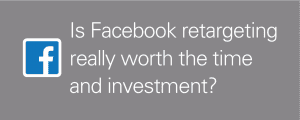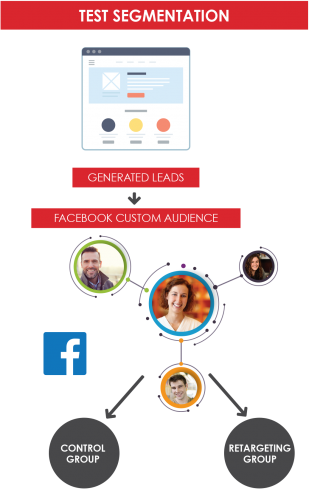Tracking your marketing efforts does not always yield clear-cut results
Your attribution model carr

Knowing this, how can you tell whether a strategy is truly paying off? You could change up your attribution model and see how the results vary, but a simpler (and oftentimes more accurate) way to gauge this is by performing a simple placebo test.
Recently The frank Agency wanted to delve into this issue to discover exactly how profitable social media retargeting is. We developed the following test to see what percentage of social media retargeting could be credited with conversion, and ended up discovering some additional insights on the profitability of these campaigns and the importance of detailed testing.
The Challenge
One of frank’s clients was using a first-touch attribution model for their sales process, so the channel that initially drew in a lead would be credited 100% with any subsequent conversions. This presented some problems, as no lead-nurturing or retargeting was shown to have contributed in any way to the conversion process. Thus, questions began to arise about the overall profitability of social media retargeting campaigns. Was it really worth it to show retargeting ads on Facebook? Or were these sales simply leads that would have converted regardless of any nurturing?
Of course, it could be deduced from past trends that some of these conversions must be due to Facebook retargeting, but the question remained of how many. In order to get hard numbers on this, we devised a test. The idea was to draw results that could be applied to future sales numbers, and would then provide an estimate of how many conversions were due to social media retargeting.
The Testing
In general, before a test is performed the market in question should be ad-free for 30 days or more. In this case, however, the market was already dark and did not need to undergo a cleansing period.
We began by developing and segmenting our Facebook Custom Audiences to receive the retargeting ads during the test. It was decided that we would only test the two top-performing products, to give us a high number of conversions from which to derive our results.
We created a list of existing leads generated from a landing page, then uploaded the list to Facebook where it was cross-referenced to find matching Facebook accounts. This gave us our Custom Audience list. Establishing a Custom Audience ensures your retargeting ads will only be seen by current leads – those that have already interacted with you in some way and thus have a higher probability of conversion.


Once our audiences were in place, they were divided into two segments: one which would see retargeting ads, and one which wouldn’t. The latter list was to be a control group, free of any retargeting influence. The leads which were set aside to receive ads would be retargeted as usual on Facebook. Segmenting leads in this manner allowed a clean comparison at the end of the study.
The ads were run for four weeks, and each week the lists were updated to remove any leads which had converted to sales. At the end of the testing period, we analyzed the number of conversions that came from each group and assessed the results.
The Results
By the end of the testing period, one product group showed a 7.7% increase in the number of conversions from those that saw the Facebook retargeting ads over those that did not. The second product group saw a 12.4% increase in conversions from the retargeting. This showed us that overall, Facebook retargeting did yield an increase in conversion, and that when we look at sales numbers in the future, we can deduce that somewhere between 7.7% and 12.4% are due to social media retargeting.


Additionally, and perhaps more impressively, the average cost-per-conversion using social media retargeting was approximately 85% lower than an average cost-per-conversion using no social media retargeting. This means that for the same cost it takes to nurture one lead through to conversion without social media retargeting, the client could convert 6.5 leads by using Facebook retargeting.
The Takeaways
The results of this study are certainly interesting, but how can they be applied? We’ve drawn a few conclusions from these outcomes that can help shape future testing and retargeting campaigns.
Facebook is a powerful lead-nurturing tool for any business model.
Once you finally have precise numbers to describe your efforts, it’s clear that Facebook retargeting is worth the investment. The low cost of the conversions yields a high ROI, so even if your total number of conversions does not increase dramatically, there is still a high degree of profitability that far outweighs the cost of the retargeting.


Success should be measured carefully.
Channel attribution should always be considered when attempting to identify a campaign’s profitability. Just as, in this case, the client’s first-touch system gave the impression that no conversions occurred from social retargeting, the opposite can also be the case. If you’re counting every view-through conversion and crediting your retargeting campaign, you’ll end up seeing skewed results that show far more conversions than can reasonably be credited to that campaign. Regularly performing tests on your campaigns can reveal the true profitability of your marketing, and let you know where to focus your budget.
Marketing needs to be viewed as a complete ecosystem, not isolated events.
Every aspect of your marketing works together to form a complex system. By understanding this and treating each point as part of a working whole, you can avoid over- or under-emphasizing the wrong points in your conversion funnel.
These implications aren’t just for one specific sector. They translate to any industry and every marketing campaign. Detailed testing and analysis need to be performed regularly to help shape and define your lead-nurturing strategies.
For more insight into social media marketing, testing and retargeting programs, contact the experts at The frank Agency. We’ve been digging into data, formulating strategies, and delivering measurable results to a wide range of industries for over 35 years – and we can do the same for you.

